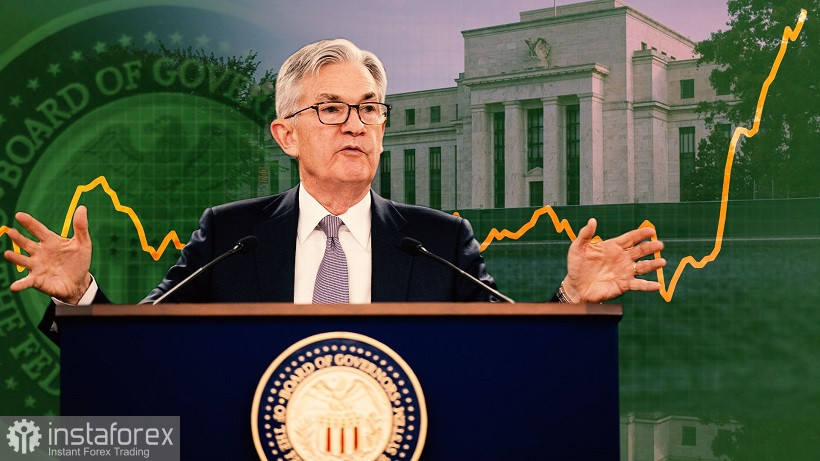Today, the US Federal Reserve will announce the results of its July meeting. This is the most important event of the month for dollar pairs, so there is no doubt that by the close of the trading day, we will see increased volatility for the EUR/USD pair. The only question is who will be the beneficiary of the inevitable price fluctuations—sellers or buyers? Obviously, everything will depend on the decisions taken by the regulator, as well as on the tone of the voiced rhetoric.

The baseline scenario for the July meeting assumes an increase in interest rates by 75 points with the simultaneous announcement of a further increase following the results of the September meeting. Any deviation from this scenario will have a huge impact on the greenback. Fed members may not justify the hawkish expectations of the dollar bulls (primarily regarding the further pace of monetary tightening) or unexpectedly exceed these expectations—if, for example, they nevertheless decide on a 100-point rate increase (or do not rule out such a scenario in September). Both sides of the scale have their own arguments and counterarguments, so the intrigue regarding the results of the July meeting will continue until the announcement of the verdict.
So, let's start with the "ultra-hawkish" scenario, which implementation is hypothetically possible, despite the improbability. The main argument in favor of this option is the continued growth of the CPI. In June, the overall consumer price index in annual terms exceeded the 9% mark—for the first time in 41 years. The core index, excluding food and energy prices, also showed record growth, reaching 5.9% year-on-year (most experts predicted a decline to 5.6%). All this suggests that inflationary pressure in the United States is still unabated. Fed Chairman Jerome Powell's optimistic hopes of inflation "leveling out" in the second half of the year collapsed—the CPI is growing at an abrupt pace, exceeding the forecast estimates of most experts.
Here, it is necessary to recall that the Bank of Canada at the July meeting unexpectedly increased the rate by 100 points, contrary to forecasts of a 75-point increase. According to the head of the Central Bank, Tiff Macklem, a "proactive" rate hike will cool domestic inflationary pressures.
Several representatives of the Fed also spoke in favor of a 100-point increase, in particular, Atlanta Fed President Raphael Bostic and San Francisco Fed President Mary Daly.
Given this information background, some analysts (for example, such financial conglomerates as Nomura Securities International and Citigroup) continue to insist that the option of a 100-point rate hike cannot be ruled out.
And yet, most experts are confident that the regulator will not wave a checker and will be satisfied with a 75-point increase in the rate. One of the arguments is Powell's rejection of the shock therapy method. If monetary policy is really aggressively tightened by raising the rate by 1%, the Fed will provoke strong volatility in the stock markets. Such prospects are unacceptable—both for the Fed in general, and for Powell, who, as a rule, makes balanced decisions.
In addition, some inflation indicators suggest that the regulator need not resort to such radical actions. For example, the latest report on the growth of the base price index for personal consumption expenditures (PCE) in the US disappointed the dollar bulls. The release reflected the slowdown in the growth of this most important inflation indicator for the Fed. Moreover, the downward dynamics on an annualized basis is fixed for the third month in a row. Also, recall the consumer confidence index, calculated by the University of Michigan. In June, it collapsed to 50 points (whereas in May it was at 58.4 points), in July it rose minimally to 51 points.
In the end, most of the Fed representatives, who voiced their position before the "silence regime" (10-day period before the meeting), said they were ready to support a 75-point rate hike. At the same time, Christopher Waller and James Bullard were skeptical about the idea of a 100-point increase.

Thus, in my opinion, the American regulator at the July meeting will implement the "baseline" scenario: it will raise the interest rate by 75 points and announce further steps in this direction, allowing a 50- or 75-point increase in the rate in September. Such results of the July meeting may disappoint the dollar bulls, after which the EUR/USD pair will head towards the upper limit of the range of 1.0130–1.0280, within which it has been trading for the second week. It would be reasonable to use this corrective pullback to open short positions. In my opinion, a possible weakening of the greenback will be temporary, at least in tandem with the euro. Longs look a priori risky, given the array of problems that pressure the euro.
For example, today, the price of gas in Europe has already overcome the mark of $2,500 per thousand cubic meters against the backdrop of a reduction in Russian gas supplies via Nord Stream. Fears spread on the market regarding an even greater reduction in Russian gas supplies on the eve of the autumn-winter period, after which the "blue fuel" began to rise in price, as is electricity. There are currently no prerequisites for changing the situation in the opposite direction. The latest reports from PMI, ZEW, IFO, and GfK are eloquent evidence of growing pessimism in the European business environment.
At the same time, the US currency is the beneficiary of the current situation. Geopolitical tensions, the energy crisis, high inflation and the risk of a global recession are all driving up demand for the safe-haven dollar.
All this suggests that any more or less large-scale corrective pullbacks for the EUR/USD pair should be used to open short positions. Downward targets are 1.0150, 1.0100 (bottom line of Bollinger Bands on H4 timeframe), 1.0050. The main target in the medium term is the level of parity.





















